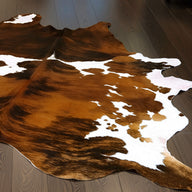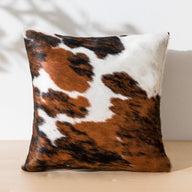No doubt about it: Real Cowhide Rug Leather is Better than Faux Cowhide Leather!

Decorating your home is an art to express your unique style and create a space where your family can thrive, share, and be themselves. For those like us, who cherish family values and a connection to their roots, Cowhide rugs offer a touch of nature and elegance that synthetic leathers simply can't match, and we are going to show you why. In this article, we will delve into the differences between Cowhide rugs and synthetic leathers, exploring their characteristics, sensory differences, durability, environmental impact, and more. By the end, you'll have a clearer understanding of why Cowhide rugs stand out as a superior choice for your home decor and much more if it is one of our brands.
General Characteristics of Cowhide

Cowhide rugs are made from the natural hide of cows, and each piece is unique, boasting its distinct patterns and colors. This individuality is one of the key appeals of cowhide rugs. They bring a touch of natural and unique beauty into your home, with variations that make each rug a REAL one-of-a-kind piece. The craftsmanship involved in creating cowhide rugs is rooted in rich traditions, especially in countries like Italy and Brazil, where the history of leatherworking is profound. Italian and Brazilian artisans use techniques passed down through generations to ensure that each cowhide rug is not only beautiful but also durable.
These cowhides are known for their robust texture and natural resilience. Their natural origin makes them hypoallergenic, which means they do not trap dust and allergens like some synthetic materials can. This makes them an excellent choice for families, providing a healthy and stylish addition to any room. The tanning process, which is done using natural methods, further enhances the durability of cowhide rugs, ensuring that they can withstand the wear and tear of daily life while maintaining their aesthetic appeal, and the sophisticated touch to real daily life.
General Characteristics of Synthetic Leather

Synthetic leather, also known as faux leather or PU leather, is a man-made material designed to mimic the look and feel of real leather. It is typically made from a plastic base and treated with various chemicals to achieve the desired texture and appearance. While synthetic leather can be made to look quite similar to genuine leather, it lacks the natural variations and unique characteristics that make cowhide so special.
That lack of personality and use and abuse of chemicals make it cheaper, but not better, making it a popular choice for budget-conscious consumers. Additionally, synthetic leather is available in a wide range of colors and finishes, offering more versatility in terms of design options but less original. Also, this comes at the cost of quality and durability.
Synthetic leather tends to be less durable than cowhide. It can crack and peel over time, especially when exposed to direct sunlight or extreme temperatures. While advancements in manufacturing have improved the quality of synthetic leather, it still does not match the longevity and resilience of natural cowhide. Furthermore, synthetic leather is not biodegradable and can have a significant environmental impact, as it is made from petroleum-based materials.
Differences in Smell
One of the most noticeable differences between cowhide and synthetic leather is the smell. The genuine cowhide has a distinct, natural aroma that is often described as earthy or rich, some that it is part of the natural experience that all family members, even the fur ones enjoy. This scent is a byproduct of the tanning process and the natural oils present in the hide. For many, the smell of real leather is a mark of authenticity and adds to the overall sensory experience of owning a cowhide rug.
In contrast, synthetic leather often has a chemical odor due to the materials and processes used in its production. This smell can be off-putting and may linger for some time after purchase. While some manufacturers attempt to mask this odor with artificial scents, it rarely replicates the genuine smell of real leather.
For those who appreciate the sensory qualities of natural materials, cowhide's aroma is a significant advantage.
Differences in Touch

Another key difference between cowhide and synthetic leather is the way they feel. Cowhide is known for its soft, supple texture that becomes even more comfortable with time. The natural grain of cowhide provides a tactile experience that synthetic leather cannot replicate. Each piece of cowhide has its own unique feel, adding to the overall charm and authenticity of the material, and making it possible for all families to feel closer to a natural experience.
Synthetic leather, on the other hand, often feels more rigid and less pliable than cowhide. While it can be manufactured to mimic the texture of real leather, it lacks the depth and natural variations found in genuine cowhide. Over time, synthetic leather can become less flexible and more prone to cracking, especially in high-use areas. This difference in touch sensation is a crucial factor for those who prioritize comfort and authenticity in their home decor.
Differences in Natural Marks
Cowhide rugs are celebrated for their natural markings, which tell a story of the animal's life. These marks can include scars, color variations, and unique patterns that add character and authenticity to each rug. These natural imperfections are seen as a testament to the cowhide's journey and are often considered a desirable feature by those who appreciate the beauty of natural materials.
In contrast, synthetic leather is manufactured to be uniform and free of imperfections. While this can create a sleek and consistent appearance, it lacks the individuality and character that come with genuine cowhide. For those who value the unique and organic qualities of natural materials, cowhide's natural marks are a significant advantage.
Differences in Durability

Durability is a crucial factor when choosing between cowhide and synthetic leather. Cowhide rugs are renowned for their longevity and ability to withstand daily use. The natural fibers in cowhide are incredibly strong, making these rugs resistant to wear and tear. This inherent strength ensures that cowhide rugs can handle the rigors of high-traffic areas without losing their charm. Additionally, Cowhide rugs are less prone to cracking, fading, or fraying, which are common issues with synthetic leather. With proper care, which includes regular cleaning and conditioning, a cowhide rug can last for many years, retaining its beauty and functionality while providing a cozy, luxurious feel to any room. This makes cowhide rugs not just a stylish choice but a wise investment for your home.
Synthetic leather, while initially durable, tends to degrade more quickly over time. Exposure to sunlight, heat, and general use can cause synthetic leather to crack, peel, and lose its appearance. While it may be a cost-effective option in the short term, synthetic leather does not offer the same long-term value as genuine cowhide. Investing in a cowhide rug ensures that you are getting a product that will stand the test of time and provide lasting beauty in your home.
Environmental Considerations
In today's eco-conscious world, the environmental impact of the materials we choose for our homes is more important than ever. Cowhide rugs are a sustainable choice as they are a byproduct of the meat industry. This means that no animals are harmed solely for their hides, and using cowhide helps reduce waste. Additionally, many cowhide producers, particularly those in Italy and Brazil, employ traditional tanning methods that are less harmful to the environment compared to synthetic processes.
Synthetic leather, however, is made from non-renewable resources and involves a production process that can be detrimental to the environment. The chemicals used in making synthetic leather can be harmful, and the material itself is not biodegradable, contributing to long-term environmental pollution. Choosing cowhide over synthetic leather is a more sustainable option that aligns with a commitment to environmental responsibility.
Applications and Uses

Both cowhide and faux cowhide leather have a range of applications, but cowhide's natural beauty and durability make it particularly well-suited for home decor. Cowhide rugs can be used in various settings, from living rooms and bedrooms to studios and offices. They add a touch of rustic elegance and can complement a wide range of interior styles, from modern minimalist to traditional rustic.
Synthetic leather is often used in furniture upholstery, fashion accessories, and automotive interiors. While it can offer a sleek and uniform look, it lacks the character and warmth of genuine cowhide. For those looking to create a unique and inviting home environment, cowhide rugs offer a level of sophistication and authenticity that synthetic materials cannot match.
Tips for Differentiating Between Cowhide and Synthetic Leather
Identifying genuine cowhide from synthetic leather can sometimes be challenging, especially with advancements in manufacturing techniques. Here are a few tips to help you distinguish between the two:
- Look for natural variations: Genuine cowhide will have unique patterns, scars, and color variations, while synthetic leather tends to be more uniform.
- Smell the material: Real cowhide has a distinct, earthy aroma, whereas synthetic leather often smells like chemicals.
- Feel the texture: Cowhide is soft and supple, with a natural grain, while synthetic leather can feel more rigid and less pliable.
- Check the edges: The edges of genuine cowhide are often more irregular and organic, while synthetic leather usually has straight, machine-cut edges.
- Examine the back: The back of genuine cowhide will have a natural suede texture, while synthetic leather typically has a fabric or plastic backing.
- By paying attention to these details, you can ensure that you are choosing genuine cowhide for your home, bringing a touch of nature's elegance into your living spaces.
Final words
Cowhide rugs stand out for their unique beauty, durability, and sustainability. Each rug is a one-of-a-kind piece, showcasing natural patterns and textures that synthetic materials simply cannot replicate. This individuality adds a personal touch to your home decor, making it truly special. Beyond aesthetics, cowhide rugs offer exceptional durability, capable of withstanding the wear and tear of everyday life. They are a testament to the quality and craftsmanship that go into their production, reflecting a deep respect for traditional methods.
By incorporating cowhide rugs into your home, you embrace a lifestyle that values quality, sustainability, and the beauty of natural materials. This choice creates a warm, inviting atmosphere for your family, making your home really yours, and bringing a lot of personality with a piece that Will bring timeless elegance.
Experience the timeless elegance of cowhide and discover the difference that genuine craftsmanship can make in your home decor. Each cowhide rug is a masterpiece, meticulously crafted to bring out the natural beauty and uniqueness of the hide. The intricate patterns and rich textures tell a story of heritage and artistry, transforming any space into a sophisticated haven. Unlike mass-produced synthetic options, cowhide rugs exude authenticity and character, adding a layer of depth to your interior design. Their natural warmth and durability ensure they will be a cherished part of your home for years to come to enjoy with your loved ones.


































